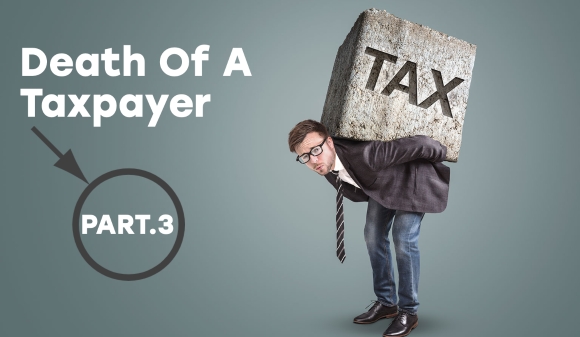Death of a Taxpayer – Part Three

 Nine years ago, MoneySaver published Brian’s four-part article dealing with the death of a taxpayer. In this edition, we continue the running of an updated version of the article.
Nine years ago, MoneySaver published Brian’s four-part article dealing with the death of a taxpayer. In this edition, we continue the running of an updated version of the article.
Lana, Editor-in-Chief
This is the third article dealing with the death of a taxpayer. Part one presented the income tax implications of death, part two dealt with special income tax rules for paying the deceased’s income tax liability as well as capital loss utilization in the year of death and part four highlights strategies to minimize income tax due on death.
This article deals with the filing of deceased’s mandatory personal income tax return and optional separate personal income tax returns that may be filed as well.
Estate Trustee’s Responsibilities
As part of the many tasks an estate trustee has in dealing with a deceased’s affairs, the trustee is responsible for filing the final personal income tax return of the deceased. The estate trustee also has the responsibility for the income tax return filing of the deceased’s estate.
Personal Income Tax Returns
The personal income tax returns needed to be prepared for the deceased are:
- any unfiled personal income tax returns for years before the year of death, and
- a personal income tax return for the year of death which is referred to as the mandatory final (or terminal) personal income tax return.
In addition to the mandatory final personal income tax return of the deceased, the estate trustee can file up to three optional separate personal income tax returns for the deceased. Filing multiple personal income tax returns will minimize the income tax bill of the deceased and, conversely, maximize the value of the estate being passed to the beneficiaries. These optional separate personal income tax returns are discussed below.
Estate Income Tax Return
In addition to the personal income tax return filing requirements, the estate must file an estate income tax return for income earned after death. As an estate is treated as a trust for income tax purposes, the income tax return filed by an estate is a “trust income tax and information return”.
The number of yearly estate income tax returns to be filed will depend on how quickly the estate is wound-up and the assets are distributed to the beneficiaries. Where the deceased indicated in their Will that the estate is to be carried on for a specific purpose, an estate income tax return will be needed for each year the estate remains in existence.
Final Personal Income Tax Return Of The Deceased
A final personal income tax return is required to be filed for the deceased and is to include the income earned from January 1st in the year of death up to and including the date of death. This income, assuming there is no surviving spouse to pass assets to, will include the capital gains and recapture caused by the deemed sale of assets owned at death as well as the value of any Registered Retirement Savings Plan (RRSPs) and Registered Retirement Income Fund (RRIFs) held at the time of death.
This purpose of this personal income tax return is to report all the deceased’s income excluding any income that has been reported on an optional separate personal income tax return. The mandatory final personal income tax return and the income tax is due by April 30th (June 15th if the deceased was self-employed) of the year following the year of death or six months after death, whichever is later.
Advantage Of Filing Separate Optional Personal Income Tax Returns
In opting to file separate personal income tax returns, the total income tax liability on death can be minimized by taxing certain types of income at lower income tax rates. In shifting these types of income to separate personal income tax returns, the total income reported on the mandatory final personal income tax return is less. Graduated income tax brackets can be taken advantage of on both the separate personal income tax returns and the mandatory final personal income tax return. If all the income was reported on the mandatory final personal income tax return, the overall effective income tax rate would be higher.
Also, by filing separate personal income tax returns, certain income tax credits may be claimed in full on more than one return: once on the mandatory final personal income tax return as well as on each of the applicable separate personal income tax returns. The income tax credits that may be claimed in full—as personal income tax credits are not prorated for the time in a year the taxpayer was alive - on each of the returns are:
- the basic, age and spouse or common-law income tax credits,
- the eligible dependent tax credit and
- the Canada caregiver income tax credit.
Other income tax credits (tuition, education and textbook, disability, pension, charitable donation, medical expense) may be claimed on any of the returns or split between the personal income tax returns. The total credit cannot exceed the maximum credit that would be available if no separate personal income tax returns were filed. The medical expense income tax credit can be claimed to the extent the medical expenses exceed the lessor:
- the threshold of $2,421 (2021), and
- three per cent of the total net income reported on all the personal income tax returns filed for the deceased.
Optional Separate Personal Income Tax Returns
Personal income tax return for rights or things
The return for rights or things is the most common of the three separate personal income tax returns that may be filed. The return for rights or things can be filed to report income that had been earned and owed to the deceased at the time of death but had not been received prior to death.
Examples of rights and things include:
- salary and wages owed for a pay period that ended before death,
- declared bonus,
- vacation pay,
- interest earned to a payment date before death,
- unpaid dividends declared before death and
- work-in-progress, where the deceased was a self-employed professional (e.g., accountant, dentist, lawyer, medical doctor, veterinarian, chiropractor) that had elected to exclude work-in-progress in calculating professional income.
These income sources are items that normally would not be included in an individual’s taxable income until received. However, because of the taxpayer’s death, they are subject to income tax in the year of death. In filing the separate personal income tax return for rights and things, tax relief is available in respect of these additional income sources.
Other optional separate personal income tax returns
Optional separate personal income tax returns can also be filed in the year of death:
- when the deceased was a beneficiary of an estate which has been designated as graduated rate estate (GRE), (which is discussed in part four) of another deceased individual or
- when the deceased had been self-employed and earned income through a partnership or proprietorship with a non-calendar year end.
Both separate personal income tax returns allow the deceased to avoid including more than twelve months of income earned in their final personal income tax return.
Take an example of a taxpayer that died on October 31, 2020. Assume the deceased was a beneficiary of a graduated rate estate with a taxation year end of June 30, 2020 or is self-employed with a business having a June 30, 2020 taxation year end. If it were not for these separate personal income tax returns, the deceased’s final personal income tax return would include:
- income from the estate or the business for the year ending June 30, 2020 plus
- income earned in the four-month stub-period of July 1 to October 31, 2020.
That means that the final personal tax return of the deceased would need to include sixteen months of income. Here, the estate trustee can decide to exclude the income earned in the four-month stub-period from the mandatory final personal income tax return and report it on a separate personal income tax return to lower the income tax liability on this income.
Brian J. Quinlan, CPA, CA, CFP, TEP
Campbell Lawless LLP,Chartered Professional Accountants
bjq@clcpa.ca

